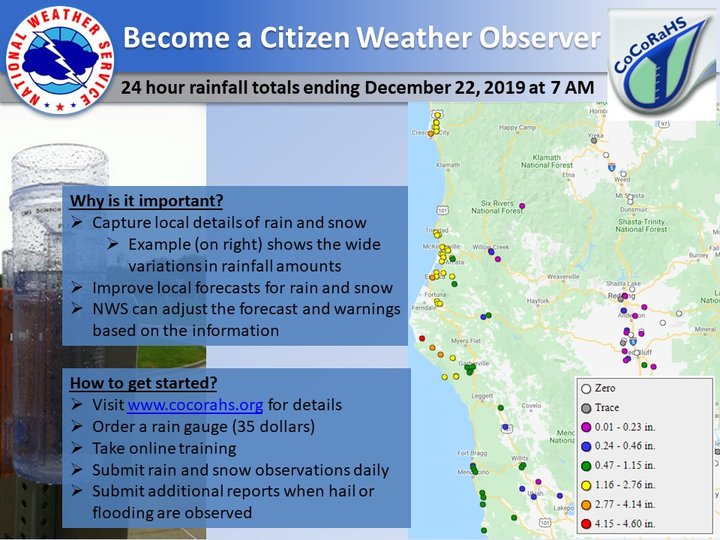
###
Press release from our good friends at the National Weather Service’s local headquarters on Woodley Island:
Citizen Science Program needs your help observing the weather!
Do you ever wonder how much rainfall you received from a recent thunderstorm? How about snowfall during a winter storm? If so, an important volunteer weather observing program needs your help! The Community Collaborative Rain, Hail, and Snow network, or CoCoRaHS, is looking for new volunteers across northwest California. The grassroots effort is part of a growing national network of home-based and amateur rain spotters with a goal of providing a high density precipitation network that will supplement existing observations.
CoCoRaHS came about as a result of a devastating flash flood that hit Fort Collins, Colorado, in July 1997. A local severe thunderstorm dumped over a foot of rain in several hours while other portions of the city had only modest rainfall. The ensuing flood caught many by surprise and caused $200 million in damages. CoCoRaHS was born in 1998 with the intent of doing a better job of mapping and reporting intense storms. As more volunteers participated, rain, hail, and snow maps were produced for every storm showing fascinating local patterns that were of great interest to scientists and the public. Recently, drought reporting has also become an important observation within the CoCoRaHS program across the nation. In fact, drought observations from CoCoRaHS are now being included in the National Integrated Drought Information System.
Volunteers may obtain an official rain gauge through the CoCoRaHS website (http://www.cocorahs.org) for about $35 plus shipping. Besides the need for an official 4-inch plastic rain gauge, volunteers are required to take a simple training module online and use the CoCoRaHS website to submit their reports. Observations are immediately available on maps and reports for the public to view. The process takes only five minutes a day, but the impact to the community is tenfold: By providing high quality, accurate measurements, the observers are able to supplement existing networks and provide useful results to scientists, resource managers, decision makers and other users.
We are in need of new observers across the entire state, however we would like to emphasize rural locations and areas of higher terrain. A storm like the one that came through January 15th and 16th highlights the importance of having numerous rain and snow observations in a variety of areas. This helps us study the storm and improve our forecasts for the next one.
How does one become a CoCoRaHS observer? Go to the CoCoRaHS website above and click on the “Join CoCoRaHS” emblem on the upper right side of the main website. After registering, take the simple online training, order your 4 inch rain gauge and start reporting! If you have any questions, feel free to email Matthew Kidwell at the NWS in Eureka at matthew.kidwell@noaa.gov or call at 707-443-6484 and talk to Matthew Kidwell or Kathleen Zontos.
CLICK TO MANAGE